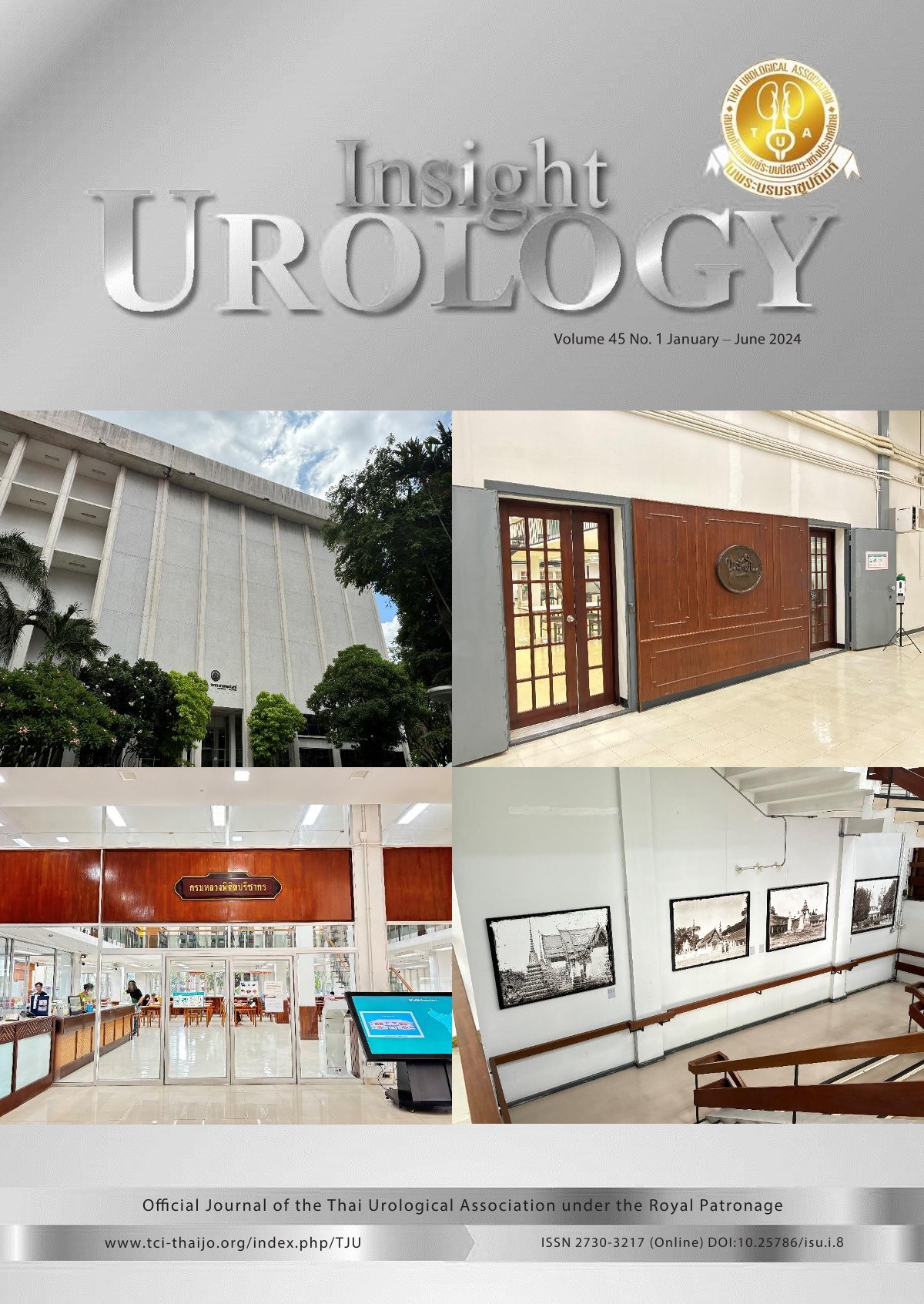Cardiovascular risk and urolithiasis: underestimated or unknown relationship?
DOI:
https://doi.org/10.52786/isu.a.84Keywords:
Urolithiasis, kidney stones, risk factor, cardiovascular disease, metabolic syndrome and obesity.Abstract
Objective: Urolithiasis, a multifactorial disease, is increasingly recognized for its association with cardiovascular disease (CVD), a leading global cause of morbidity and mortality. Despite the establishment of links between urolithiasis and CVD risk factors such as diabetes, obesity, and hypertension, this relationship remains underexplored. This study aims to characterize the trend of information regarding cardiovascular risk and urolithiasis through comprehensive bibliometric analysis, highlighting the importance of investigating this association further.
Materials and Methods: We searched publications between 2002 and 2022 on the Web of Science (WOS) database, filtered by exclusion criteria. Impact factor (IF) 2021 and Journal Citation Reports (JCR) were evaluated and analyzed by mapping using VOSviewer.
Results: We obtained 63 articles from 49 journals over the last two decades, identifying an increase in publications in the last two years without a rising annual trend. Gambaro G is the author of most citations (12,317), underscoring the extent of the global and interdisciplinary effort in understanding the cardiovascular implications of urolithiasis. Our findings highlight the varied impact of journals, with IFs ranging from 1 to 10.6, and point to a significant yet overlooked global research interest in the intersection between urolithiasis and cardiovascular risk. The USA was the country with the most publications (20.6%) followed by Taiwan (12.6%) and Spain (9.5%). Despite the observed increase, the rate of publications especially in high-impact journals remains low, particularly in Latin America, indicating a need for heightened research efforts in this important field.
Conclusion: This bibliometric analysis underscores a growing yet insufficient global scholarly interest in the relationship between urolithiasis and cardiovascular risk. Despite some high-impact publications, the overall scarcity points to a need for increased research efforts, particularly in underrepresented regions such as Latin America. The study calls for a broader interdisciplinary collaboration to further understand and address the cardiovascular implications of urolithiasis, aiming to improve patient care and outcomes in this significant public health intersection.
References
Yasui T, Okada A, Hamamoto S, Ando R, Taguchi K, Tozawa K, et al. Pathophysiology-based treatment of urolithiasis. Int J Urol 2017;24:32-8.
Alexander RT, Hemmelgarn BR, Wiebe N, Bello A, Samuel S, Klarenbach SW, et al. Kidney stones and cardiovascular events: a cohort study. Clin J Am Soc Nephrol 2014;9:506-12.
Stern JM, Moazami S, Qiu Y, Kurland I, Chen Z, Agalliu I, et al. Evidence for a distinct gut microbiome in kidney stone formers compared to non-stone formers. Urolithiasis 2016;44:399-407.
Scales CDJr, Tasian GE, Schwaderer AL, Goldfarb DS, Star RA, Kirkali Z. Urinary stone disease: advancing knowledge, patient care, and population health. Clin J Am Soc Nephrol 2016;11:1305-12.
Ziemba JB, Matlaga BR. Epidemiology and economics of nephrolithiasis. Investig Clin Urol 2017;58:299-306.
Arafa A, Eshak ES, Iso H, Shirai K, Muraki I, Sawada N, et al. Urinary stones and risk of coronary heart disease and stroke: the Japan Public Health Center-Based Prospective Study. J Atheroscler Thromb 2020;27:1208-15.
van Eck NJ, Waltman L. Software survey: VOSviewer, a computer program for bibliometric mapping. Scientometrics 2010;84:523-38.
Yencilek E, Sarı H, Yencilek F, Yeşil E, Aydın H. Systemic endothelial function measured by flow-mediated dilation is impaired in patients with urolithiasis. Urolithiasis 2017;45:545-52.
Choy SH, Nyanatay SA, Sothilingam S, Malek R, JR S, Toh CC, et al. Cardiovascular risk factors, ethnicity and infection stone are independent factors associated with reduced renal function in renal stone formers. PLoS ONE 2022;17:e0265510.
Taylor ER, Stoller ML. Vascular theory of the formation of Randall plaques. Urolithiasis 2015;43:41-5.
Ferraro PM, Robertson WG, Johri N, Nair A, Gambaro G, Shavit L, et al. A London experience 1995-2012: demographic, dietary and biochemical characteristics of a large adult cohort of patients with renal stone disease. QJM 2015;108:561-8.
Aydin H, Yencilek F, Erihan IB, Okan B, Sarica K. Increased 10-year cardiovascular disease and mortality risk scores in asymptomatic patients with calcium oxalate urolithiasis Urol Res 2011;39:451-8.
Geraghty RM, Cook P, Roderick P, Somani B. Risk of Metabolic Syndrome in Kidney Stone Formers: A Comparative Cohort Study with a Median Follow-Up of 19 Years. J Clin Med 2021;10:978.
Domingos F, Serra A. Nephrolithiasis is associated with an increased prevalence of cardiovascular disease. Nephrol Dial Transplant 2011;26:864-8.
Hamano S, Nakatsu H, Suzuki N, Tomioka S, Tanaka M, Murakami S. Kidney stone disease and risk factors for coronary heart disease. Int J Urol 2005;12:859-63.
Bargagli M, Moochhala S, Robertson WG, Gambaro G, Lombardi G, Unwin RJ, et al. Urinary metabolic profile and stone composition in kidney stone formers with and without heart disease. J Nephrol 2022;35:851-7.
Saenz-Medina J, Muñoz M, Rodriguez C, Sanchez A, Contreras C, Carballido-Rodríguez J, et al. En- dothelial Dysfunction: An Intermediate Clinical Feature between Urolithiasis and Cardiovascular Diseases. Int J Mol Sci 2022;23:912.
Yasui T, Fujita K, Hayashi Y, Ueda K, Kon S, Maeda M, et al. Quantification of osteopontin in the urine of healthy and stone-forming men. Urol Res 1999;27:225-30.
Yasui T, Fujita K, Hayashi Y, Ueda K, Kon S, Maeda M, Uede T, et al. Quantification of osteopontin in the urine of healthy and stone-forming men. Urol Res 1999;27:225-30.
Patiño-Villada F, Arango-Vélez EF, Quintero-Velásquez MA, Arenas-Sosa MM. Factores de riesgo cardiovascular en una población urbana de Colombia. Rev Saud Pública 2011;13:433-45.
Gómez JE. Morbimortalidad cardiovascular en el mundo. Rev Colomb Cardiol 2012;19:298-9.
He L, Fang H, Wang X, Wang Y, Ge H, Li C, et al. The 100 most-cited articles in urological surgery: A bibliometric analysis. Int J Surg 2020;75:74-9.
Murugathas K, Navaneethakrishnan S. Bibliometric analysis of the most cited articles in urolithiasis. Sri Lanka Libr Rev 2020;34:105.
Downloads
Published
How to Cite
Issue
Section
License
Copyright (c) 2024 Insight Urology

This work is licensed under a Creative Commons Attribution-NonCommercial-NoDerivatives 4.0 International License.



